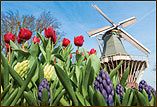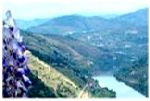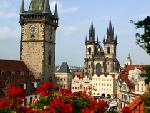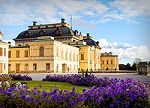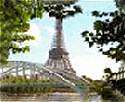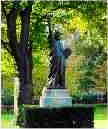Tower Lighting
Lighting from Construction
to 1985
Initially, the Eiffel Tower was lighted by gas, having some 10,000
gas street lamps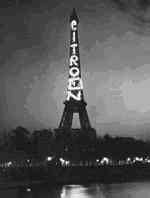 lighting the tower and platforms. This was upgraded to
electrical lighting, using 3,200 lamps, for the Universal Exposition of 1900. Since then,
the tower's lighting has been enhanced periodically. In 1925, Andrť CitroŽn lighted up the tower,
using 250,000 colored lights, with a boldly lighted advertisement for his
company spelling out the word "CitroŽn". In 1937, for the International
Exposition of Arts and Techniques, Andrť Granet added colored lighting
to the tower. 252 Yellow-orange sodium tinted lamps were installed in
1985.
lighting the tower and platforms. This was upgraded to
electrical lighting, using 3,200 lamps, for the Universal Exposition of 1900. Since then,
the tower's lighting has been enhanced periodically. In 1925, Andrť CitroŽn lighted up the tower,
using 250,000 colored lights, with a boldly lighted advertisement for his
company spelling out the word "CitroŽn". In 1937, for the International
Exposition of Arts and Techniques, Andrť Granet added colored lighting
to the tower. 252 Yellow-orange sodium tinted lamps were installed in
1985.
In 1975 a revolving beacon replaced the fixed navigational red light
at the summit. Subsequently, in 1986, 2 light beacons were installed
that are capable of being seen 80 km away. The beacons are activated
when the tower is lighted up at night.
The beacons consist of 4 marine-type, motorized light projectors which
are computer controlled. 6000 watt Xenon lamps, that have a 1200 hour
light expectance, are used. The lamps are integrated with a temperature
controlled heating and cooling system; heating is automatically
activated when the ambient temperature drops below zero degrees
centigrade.
Lighting from 1986 to
Present
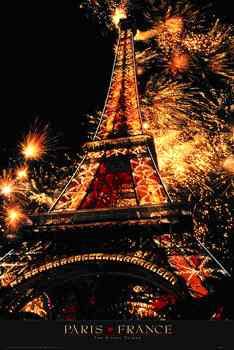 During 1986 a new,
two tiered, lighting system was installed to provide both normal and
'sparkle' lighting. The new system consists of some 20,000 special
light bulbs covering the whole of the tower; that's 5,000 per side [in
case you're wondering, they weigh a total of 8 tons]. The system has
230 enclosed lighting fixtures and electrical boxes, networking 800
strings of lights measuring 18 km long. The new lighting installation
required 25 mountain climbers who worked for 5 months to set up the
system. During 1986 a new,
two tiered, lighting system was installed to provide both normal and
'sparkle' lighting. The new system consists of some 20,000 special
light bulbs covering the whole of the tower; that's 5,000 per side [in
case you're wondering, they weigh a total of 8 tons]. The system has
230 enclosed lighting fixtures and electrical boxes, networking 800
strings of lights measuring 18 km long. The new lighting installation
required 25 mountain climbers who worked for 5 months to set up the
system.
For 5 days,
commencing January 24, 2004, the tower was lighted all night in scarlet
red to celebrate the Chinese New Year. The
tower consumes 7.5 million kilowatts of electricity per year.
Currently, there is controversy over
photographing the tower at night [see copyright below].
Eiffel Tower
Fireworks Poster |
|
|
The Elevators
The builders of the Eiffel Tower were challenged by
the technical questions raised by the installation of the elevators.
First of all, there was no experience relating to the installation of
elevators climbing to such heights while carrying the required loads.
Secondly, there were the further complexities introduced by the slanting
tracks to be negotiated at the various angles. The first elevators were
installed in May, 1889; all were operational by the following June 16th.
Over the years, the elevators have traveled about 100,000 km per annum.
From the Ground
Level to the 2nd Level
The original hydraulically powered elevators, in the east and west
piers, were replaced in 1897 and 1899 with elevators from another
company that had 16-meter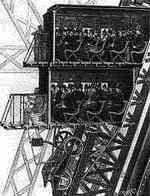 long main pistons and hydraulic accumulators.
These were used into the 1980s. long main pistons and hydraulic accumulators.
These were used into the 1980s.
The elevators in the north and south piers were scrapped in 1900 and
1912 respectively. The replacements were used until upgraded, in 1995,
with new cabins and computer controls.
In 1983, a new customer elevator was installed to take customers up to
the Jules Verne Restaurant; it was
| augmented by a service elevator that
was fitted out in 1989. |
|
Elevator to
2nd Level |
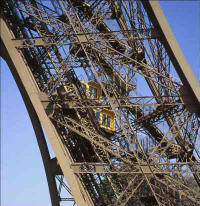 The elevators can move both up and down at two different angles to match
the angles of the tower's legs. The double decked elevators in the
north, east, and west piers are generally comparable; the one in the
south pier is used to take Jules Verne customers from the ground level
up to the restaurant itself. This pier also contains the stairway
between the ground and second levels. The elevators can move both up and down at two different angles to match
the angles of the tower's legs. The double decked elevators in the
north, east, and west piers are generally comparable; the one in the
south pier is used to take Jules Verne customers from the ground level
up to the restaurant itself. This pier also contains the stairway
between the ground and second levels. |



 lighting the tower and platforms. This was upgraded to
electrical lighting, using 3,200 lamps, for the Universal Exposition of 1900. Since then,
the tower's lighting has been enhanced periodically. In 1925, Andrť CitroŽn lighted up the tower,
using 250,000 colored lights, with a boldly lighted advertisement for his
company spelling out the word "CitroŽn". In 1937, for the International
Exposition of Arts and Techniques, Andrť Granet added colored lighting
to the tower. 252 Yellow-orange sodium tinted lamps were installed in
1985.
lighting the tower and platforms. This was upgraded to
electrical lighting, using 3,200 lamps, for the Universal Exposition of 1900. Since then,
the tower's lighting has been enhanced periodically. In 1925, Andrť CitroŽn lighted up the tower,
using 250,000 colored lights, with a boldly lighted advertisement for his
company spelling out the word "CitroŽn". In 1937, for the International
Exposition of Arts and Techniques, Andrť Granet added colored lighting
to the tower. 252 Yellow-orange sodium tinted lamps were installed in
1985. During 1986 a new,
two tiered, lighting system was installed to provide both normal and
'sparkle' lighting. The new system consists of some 20,000 special
light bulbs covering the whole of the tower; that's 5,000 per side [in
case you're wondering, they weigh a total of 8 tons]. The system has
230 enclosed lighting fixtures and electrical boxes, networking 800
strings of lights measuring 18 km long. The new lighting installation
required 25 mountain climbers who worked for 5 months to set up the
system.
During 1986 a new,
two tiered, lighting system was installed to provide both normal and
'sparkle' lighting. The new system consists of some 20,000 special
light bulbs covering the whole of the tower; that's 5,000 per side [in
case you're wondering, they weigh a total of 8 tons]. The system has
230 enclosed lighting fixtures and electrical boxes, networking 800
strings of lights measuring 18 km long. The new lighting installation
required 25 mountain climbers who worked for 5 months to set up the
system. long main pistons and hydraulic accumulators.
These were used into the 1980s.
long main pistons and hydraulic accumulators.
These were used into the 1980s. The elevators can move both up and down at two different angles to match
the angles of the tower's legs. The double decked elevators in the
north, east, and west piers are generally comparable; the one in the
south pier is used to take Jules Verne customers from the ground level
up to the restaurant itself. This pier also contains the stairway
between the ground and second levels.
The elevators can move both up and down at two different angles to match
the angles of the tower's legs. The double decked elevators in the
north, east, and west piers are generally comparable; the one in the
south pier is used to take Jules Verne customers from the ground level
up to the restaurant itself. This pier also contains the stairway
between the ground and second levels.